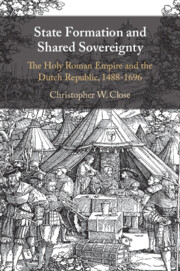
-
Select format
-
- Publisher:
- Cambridge University Press
- Publication date:
- March 2021
- February 2021
- ISBN:
- 9781108946827
- 9781108837620
- 9781108925082
- Dimensions:
- (229 x 152 mm)
- Weight & Pages:
- 0.73kg, 382 Pages
- Dimensions:
- (229 x 152 mm)
- Weight & Pages:
- 0.57kg, 382 Pages
- Subjects:
- Area Studies, European History after 1450, History, European Studies
You may already have access via personal or institutional login- Subjects:
- Area Studies, European History after 1450, History, European Studies
Book description
During the sixteenth and seventeenth centuries, dozens of alliances asserting shared sovereignty formed in the Holy Roman Empire and the Low Countries. Many accounts of state formation struggle to explain these leagues, since they characterize state formation as a process of internal bureaucratization within individual states. This comparative study of alliances in the Holy Roman Empire and the Low Countries focuses on a formative time in European history, from the late fifteenth century until the immediate aftermath of the 1648 Peace of Westphalia, to demonstrate how the sharing of sovereignty through alliances influenced the evolution of the Empire, the Dutch Republic, and their various member states in fundamental ways. Alliances simultaneously supported and constrained central and territorial authorities, while their collaborative policy-making process empowered smaller states, helping to ensure their survival. By revealing how the interdependencies of alliance shaped states of all sizes in the Empire and the Low Countries, Christopher W. Close opens new perspectives on state formation with profound implications for understanding the development of states across Europe.
Reviews
‘In his pathbreaking study, Christopher W. Close analyzes federations as an integral and in many respects indispensable part of the Holy Roman Empire’s political culture. He shows how they shaped the Empire’s face and provided the framework for its dynamic and open development for more than 150 years. Without understanding their traditions and their frictions, their common values and their complex disputes neither the empire’s civil wars nor its capability to provide for domestic peace is comprehensible.’
Thomas Lau - University of Freiburg
‘A meticulously researched, carefully argued contribution to early modern politics. The role of the enforced confessional orthodoxy of centralized states recedes far into the background. The vitality and resilience of small actors, buttressed by the Reformation and entangled in leagues whose filaments reached across Europe, rises to the fore. The corporate alliance becomes the central figure in state building. This is an important book.’
Christopher Ocker - Australian Catholic University
‘This well-researched and well-written monograph is a recent addition to the mass of scholarship that represents the Holy Roman Empire as a real, living, breathing entity … Recommended.'
C. Ingrao Source: Choice
Contents
Metrics
Altmetric attention score
Full text views
Full text views help Loading metrics...
Loading metrics...
* Views captured on Cambridge Core between #date#. This data will be updated every 24 hours.
Usage data cannot currently be displayed.
Accessibility standard: Unknown
Why this information is here
This section outlines the accessibility features of this content - including support for screen readers, full keyboard navigation and high-contrast display options. This may not be relevant for you.
Accessibility Information
Accessibility compliance for the PDF of this book is currently unknown and may be updated in the future.


